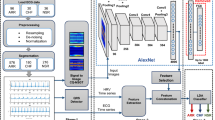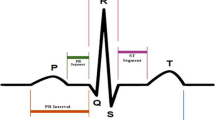Abstract
Cardiac arrhythmia is an irregular sequence of electrical impulses which result in numerous shifts in heart rhythms. Such cardiac abnormalities can be observed using a standard medical examination known as electrocardiogram (ECG). However, with the drastic increase in heart disease patients, interpreting such pulsations on ECG can be time-consuming and a challenging task. Thus, the primary objective of this paper is to propose an automated system based on a hybrid model which consists of an amalgamation of convolutional neural networks (CNN) and long short-term memory (LSTM) in order to accurately detect and classify several cardiac arrhythmia ailments. The model incorporates a feature selection algorithm, principal component analysis (PCA), that ingresses the new features into 14-layers deep one-dimensional CNN-LSTM network. The experiment is conducted using PhysionNet’s MIT-BIH and PTB diagnostics datasets and multiple strategies have been contemplated for evaluation purposes: firstly, using smooth ECG signals with filtered noise and alternatively, using signals that encompass artificially generated noise based on a Gaussian distribution. The proposed system achieved an accuracy of 99% with the denoised sets and 98% using the data with artificially generated noise, exhibiting a consistent and robust generalization performance and possesses the potential to be used as an auxiliary tool to assist clinicians in arrhythmia diagnoses.
Access this chapter
Tax calculation will be finalised at checkout
Purchases are for personal use only
Similar content being viewed by others
References
United Nation: Department of Economic and Social Affairs. Population Division. World Population Ageing: Highlights (ST/ESA/SER.A/430) (2019)
Zile M, Brutsaert D (2002) New concepts in diastolic dysfunction and diastolic heart failure: Part I: diagnosis, prognosis, and measurements of diastolic function. Circulation 105:1387–1393. American Heart Association
Thrainsdottir I, Hardarson T, Thorgeirsson G, Sigvaldason H, Sigfusson N (1993) The epidemiology of right bundle branch block and its association with cardiovascular morbidity—the reykjavik study. Eur Heart J 14(12):1590–1596. Oxford Academic
Fahy G, Pinski S, Miller D, McCabe N, Pye C, Walsh M, Robinson K (1996) Natural history of isolated bundle branch block. Am J Cardiol 77(14):1185–1190. ScienceDirect
Lown B, Wolf M (1971) Approaches to sudden death from coronary heart disease. Circulation 44(1):130–142. American Heart Association
Engström G, Hedblad B, Juul-Möller S, Tydén P, Janzon L (2000) Cardiac arrhythmias and stroke. Stroke 31(12):2925. National Library of Medicine
de Chazal P, O’Dwyer M, Reilly RB (2004) Automatic classification of heartbeats using ECG morphology and heartbeat interval features. Trans Biomed Eng 51(7):1196–1206. IEEE
Esteva A, Robicquet A, Ramsundar B, Kuleshov V, DePristo M, Chou K, Cui C, Corrado G, Thrun S, Dean J (2019) A guide to deep learning in healthcare. Nat Med 25(1). ResearchGate
For the Advancement of Medical Instrumentation, A.: Testing and reporting performance results of cardiac rhythm and ST segment measurement algorithms. 4301 N. Fairfax Dr., Suite 301. American National Standards Institute (2013)
Kohli N, Verma NK, Roy A (2010) SVM based methods for arrhythmia classification in ECG. In: International conference on computer and communication technology (ICCCT). IEEE
Kohli N, Verma NK (2011) Arrhythmia classification using SVM with selected features. Int J Eng Sci Technol 3(8). African Journals Online
Desai U, Martis RJ, Nayak CG, Sarika K, Seshikala G (2015) Machine intelligent diagnosis of ECG for arrhythmia classification using DWT, ICA and SVM techniques. In: Annual IEEE India conference (INDICON). IEEE
Gao D, Madden M, Chambers D, Lyons G (2005) Bayesian ANN classifier for ECG arrhythmia diagnostic system: a comparison study. In: Proceedings. IEEE international joint conference on neural networks. IEEE
Jadhav S, Nalbalwar SL, Ghatol A (2012) Artificial neural network models based cardiac arrhythmia disease diagnosis from ECG signal data. Int J Comput Appl 44(15):8–13. ResearchGate
Zuo WM, Lu WG, Wang KQ, Zhang H (2008) Diagnosis of cardiac arrhythmia using kernel difference weighted KNN classifier. In: Computers in cardiology. IEEE
Yang F, Du J, Lang J, Lu W, Liu L, Jin C, Kang Q (2020) Missing value estimation methods research for arrhythmia classification using the modified kernel difference-weighted KNN algorithms. BioMed Res Int: 1–9. Hindawi
Lodhi AM, Qureshi AN, Sharif U, Ashiq Z (2018) A novel approach using voting from ECG leads to detect myocardial infarction. In: Proceedings of SAI intelligent systems conference, IntelliSys: intelligent systems and applications. Springer, pp 337–352
Yıldırım Ö, Pławiak P, Tan R-S, Acharya UR (2018) Arrhythmia detection using deep convolutional neural network with long duration ECG signals. In: Computers in biology and medicine. ScienceDirect
Acharya UR, Fujita H, Oh SL, Hagiwara Y, Tan JH, Adam M (2017) Application of deep convolutional neural network for automated detection of myocardial infarction using ECG signals. Inf Sci: 415–416, 190–198. ResearchGate
Kachuee M, Fazeli S, Sarrafzadeh M (2018) ECG heartbeat classification: a deep transferable representation. In: IEEE international conference on healthcare informatics (ICHI). IEEE
Li F, Liu M, Zhao Y, Kong L, Dong L, Liu X, Hui M (2019) Feature extraction and classification of heart sound using 1D convolutional neural networks. EURASIP J Adv Sig Process (1):59. Springer
Baloglu UB, Talo M, Yildirim O, Tan RS, Acharya UR (2019) Classification of myocardial infarction with multi-lead ECG signals and deep CNN. In: Pattern recognition letters. ScienceDirect
Yin W, Kann K, Yu M, Schütze H (2017) Comparative study of CNN and RNN for natural language processing. ResearchGate
Singh S, Pandey SK, Pawar U, Janghel RR (2018) Classification of ECG arrhythmia using recurrent neural networks. Procedia Comput Sci 132:1290–1297. ScienceDirect
Schwab P, Scebba GC, Zhang J, Delai M, Karlen W (2017) Beat by beat: classifying cardiac arrhythmias with recurrent neural networks. In: Computing in cardiology conference (CinC). IEEE
Limam M, Precioso F (2017) AF detection and ECG classification based on convolutional recurrent neural network. In: 2017 computing in cardiology conference (CinC). IEEE
Goldberger AL, Amaral LAN, Glass L, Hausdorff JM, Ivanov PC, Mark RG, Stanley HE (2000) PhysioBank, PhysioToolkit, and PhysioNet: components of a new research resource for complex physiologic signals. Circulation 101(23):e215–e220. American Heart Association
Chawla NV, Bowyer KW, Hall LO, Kegelmeyer WP (2002) SMOTE: synthetic minority over-sampling technique. J Artif Intell Res 16(1):321–357. ResearchGate
Scholkmann F, Boss J, Wolf M (2012) An efficient algorithm for automatic peak detection in noisy periodic and quasi-periodic signals. Algorithms 5(4):588–603. MDPI
Gent PV, Farah H, Nes NV, Arem BV (2018) Analysing noisy driver physiology real-time using off-the-shelf sensors: heart rate analysis software from the taking the fast lane project. ResearchGate
Zheng Z, Chen Z, Hu F, Zhu J, Tang Q, Liang Y (2020) An automatic diagnosis of arrhythmias using a combination of CNN and LSTM technology. Electronics 9(1):121. MDPI
Dunford R, Su Q, Tamang E (2014) The pareto principle. Plymouth Stud Sci 7(1):140–148. University of Plymouth
Zubair M, Kim J, Yoon C (2016) An automated ECG beat classification system using convolutional neural networks. In: 2016 6th international conference on IT convergence and security (ICITCS). ResearchGate
Lu L, Shin Y, Su Y, Karniadakis GE (2019) Dying ReLU and initialization: theory and numerical examples. Cornell University
Hochreiter S, Schmidhuber J (1997) Long short-term memory. Neural Comput 9(8):1735–1780. MIT Press Direct
Yildirim Ö (2018) A novel wavelet sequence based on deep bidirectional LSTM network model for ECG signal classification. Comput Biol Med 96:189–202. ScienceDirect
Srivastava N, Hinton G, Krizhevsky A, Sutskever I, Salakhutdinov R (2014) Dropout: a simple way to prevent neural networks from overfitting. Department of Computer Science, University of Toronto. Journal of Machine Learning Research
Author information
Authors and Affiliations
Corresponding author
Editor information
Editors and Affiliations
Rights and permissions
Copyright information
© 2022 The Author(s), under exclusive license to Springer Nature Singapore Pte Ltd.
About this paper
Cite this paper
Rahman, S., Rahman, S., Bahalul Haque, A.K.M. (2022). Automated Detection of Cardiac Arrhythmia Based on a Hybrid CNN-LSTM Network. In: Marriwala, N., Tripathi, C.C., Jain, S., Mathapathi, S. (eds) Emergent Converging Technologies and Biomedical Systems . Lecture Notes in Electrical Engineering, vol 841. Springer, Singapore. https://doi.org/10.1007/978-981-16-8774-7_32
Download citation
DOI: https://doi.org/10.1007/978-981-16-8774-7_32
Published:
Publisher Name: Springer, Singapore
Print ISBN: 978-981-16-8773-0
Online ISBN: 978-981-16-8774-7
eBook Packages: EngineeringEngineering (R0)




